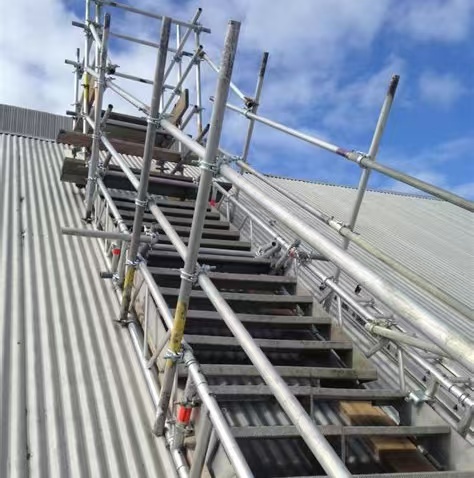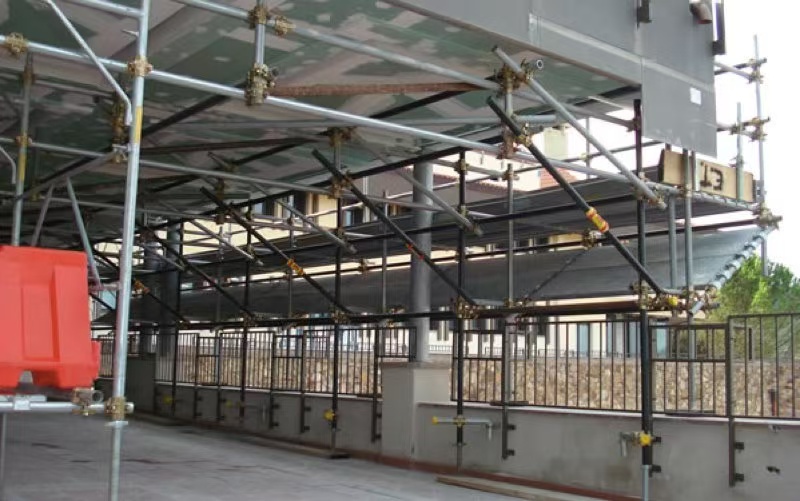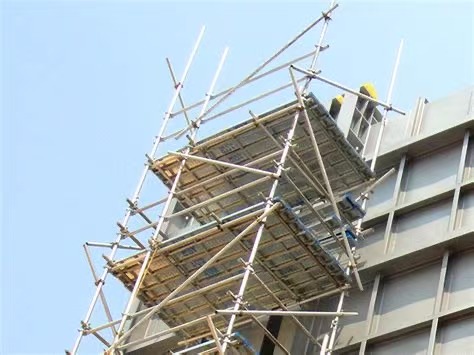Content Menu
● Introduction to Tube Scaffolding
● Components of Tube Scaffolding
● Benefits of Tube Scaffolding
>> Flexibility and Adaptability
>> Strength and Safety
● Applications of Tube Scaffolding
>> Types of Tube Scaffolding
● Assembly and Dismantling of Tube Scaffolding
● Safety Considerations
>> Inspection Checklist
● Advanced Techniques in Tube Scaffolding
>> Modular Scaffolding Systems
● Environmental Considerations
>> Sustainable Practices
● Training and Certification
>> Training Programs
● Conclusion
● FAQ
>> 1. What are the primary components of tube scaffolding?
>> 2. What are the benefits of using tube scaffolding?
>> 3. How is tube scaffolding assembled?
>> 4. What safety considerations are important for tube scaffolding?
>> 5. What types of projects typically use tube scaffolding?
● Citations:
Tube scaffolding, also known as tube and coupler scaffolding or tube and clamp scaffolding, is a versatile and robust scaffolding system widely used in the construction industry. This system employs steel tubes and couplers or clamps to create a stable and secure structure, making it ideal for various construction, maintenance, and restoration projects. In this article, we will delve into the components, benefits, and applications of tube scaffolding, as well as provide insights into its assembly and safety considerations.

Introduction to Tube Scaffolding
Tube scaffolding is composed of steel tubes and couplers or clamps, which are essential for constructing a stable and secure structure. The couplers or clamps connect the tubes at various intervals, adhering to engineering standards and regulations. This scaffolding system offers several significant benefits, including flexibility, adaptability, strength, and safety.
Components of Tube Scaffolding
1. Scaffold Tubes: These are the primary structural elements that provide the high-strength skeleton of the scaffold. Employed in combination with versatile coupler clamps, they enable the assembly of scaffolding that can withstand considerable loads and offer flexibility in design.
2. Coupler Clamps: These include swivel, sleeve, and putlog varieties, ensuring secure joins between tubes. They allow for custom scaffold shapes to meet complex construction requirements.
3. Scaffold Fittings: These encompass a wide variety of specialized components such as girder couplers and board retaining couplers. They play a pivotal role in scaffold safety and functionality by ensuring tubes and boards are firmly held in place.
Benefits of Tube Scaffolding
Tube scaffolding is highly versatile and can be assembled into various configurations, such as birdcage scaffolding, suspended scaffolding, and supported scaffolding, to meet the specific needs of different projects. Its adaptability allows it to be used across a wide range of industries, including construction, maintenance, and restoration.
Flexibility and Adaptability
- Flexibility: Tube scaffolding can be customized for any project, making it ideal for use in a variety of settings. Whether you're working on a small repair job or a large commercial project, tube scaffolding can be adjusted to meet your needs.
- Adaptability: Its design allows it to be used in diverse environments, including refineries, petrochemical plants, and power plants.
Strength and Safety
- Strength: The system's ability to support heavy loads makes it ideal for projects that require a strong and stable structure, ensuring the safety and efficiency of construction activities.
- Safety: The use of high-quality couplers and tubes provides a secure and stable structure, significantly reducing the risk of accidents and injuries on the job site.

Applications of Tube Scaffolding
Tube scaffolding is commonly used in construction projects where extensive versatility is required. It is suitable for both residential and commercial applications, offering a reliable solution for building and maintenance tasks.
Types of Tube Scaffolding
1. Independent Scaffolding: This is a free-standing structure that doesn't rely on a building for support, making it ideal for projects that don't have walls or structures to attach to.
2. Putlog Scaffolding: This type is connected to the building, with one end of the tube resting on the wall of the building and the other end supported by a base plate on the ground.
3. Suspended Scaffolding: This is used for projects where workers need to work at height but can't use traditional scaffolding. The scaffolding is hung from ropes or cables, allowing workers to lift it up and down the building.
Assembly and Dismantling of Tube Scaffolding
The assembly of tube scaffolding involves connecting vertical tubes to horizontal tubes via right angle clamps, while diagonal tubes are connected using swivel clamps to provide stability to the structure. Dismantling is typically done in reverse order, ensuring that all components are safely removed and stored.
Safety Considerations
Safety is paramount when using tube scaffolding. Regular inspections of the scaffolding structure are crucial to ensure that all components are securely in place and that there are no signs of wear or damage.
Inspection Checklist
- Base Plates: Ensure they are securely positioned and level.
- Tubes: Check for any damage or corrosion.
- Clamps: Verify that they are tightened to the recommended torque.
- Bracing: Confirm that all bracing is properly installed and secure.
Advanced Techniques in Tube Scaffolding
In recent years, advancements in technology have led to the development of more sophisticated scaffolding systems. These include modular scaffolding systems that can be easily assembled and disassembled, reducing labor costs and improving efficiency.
Modular Scaffolding Systems
Modular systems are designed with interlocking components that simplify the assembly process. They are particularly useful for large-scale projects where speed and efficiency are critical.
Environmental Considerations
The use of tube scaffolding also involves environmental considerations. Ensuring that scaffolding does not damage surrounding structures or ecosystems is essential. This includes protecting vegetation and preventing soil erosion during construction.
Sustainable Practices
- Material Selection: Choosing materials that are durable and recyclable can reduce waste and minimize environmental impact.
- Site Management: Proper site management involves minimizing the footprint of the scaffolding and ensuring that all materials are removed upon completion of the project.
Training and Certification
Proper training and certification are essential for individuals working with tube scaffolding. This includes understanding safety protocols, assembly techniques, and inspection procedures to ensure compliance with industry standards.
Training Programs
- Safety Training: Focuses on recognizing hazards and preventing accidents.
- Assembly Training: Covers the correct methods for assembling and dismantling scaffolding.
- Inspection Training: Teaches how to conduct thorough inspections to ensure scaffolding safety.
Conclusion
Tube scaffolding is a versatile and robust system that offers numerous benefits in construction projects. Its flexibility, adaptability, strength, and safety features make it an ideal choice for a wide range of applications. By understanding the components, benefits, and applications of tube scaffolding, construction teams can optimize their use of this essential tool.

FAQ
1. What are the primary components of tube scaffolding?
Tube scaffolding primarily consists of steel tubes and couplers or clamps. These components work together to create a stable and secure structure for construction and maintenance projects.
2. What are the benefits of using tube scaffolding?
The benefits include flexibility, adaptability, strength, and safety. Tube scaffolding can be customized for various projects and supports heavy loads while providing a secure working platform.
3. How is tube scaffolding assembled?
Assembly involves connecting vertical tubes to horizontal tubes using right angle clamps, while diagonal tubes are connected with swivel clamps to ensure stability.
4. What safety considerations are important for tube scaffolding?
Regular inspections are crucial to ensure all components are securely in place and free from damage. Proper bracing and secure clamping are also essential for safety.
5. What types of projects typically use tube scaffolding?
Tube scaffolding is used in a variety of projects, including residential, commercial, and industrial applications. It is particularly useful in projects requiring versatility and strength, such as high-rise buildings and bridge construction.
Citations:
[1] https://scaffoldtype.com/tube-and-coupler-scaffolding/
[2] https://www.youtube.com/watch?v=ZM6Tlh_NAnQ
[3] https://blog.csdn.net/weixin_40289064/article/details/79669930
[4] https://en.wikipedia.org/wiki/Tube_and_clamp_scaffold
[5] https://www.istockphoto.com/videos/scaffolding-tube
[6] https://blog.csdn.net/qq_34917728/article/details/125122327
[7] https://www.grinsulating.com/top-benefits-tube-and-clamp-scaffold/
[8] https://www.youtube.com/watch?v=_La74H8RUhA






















